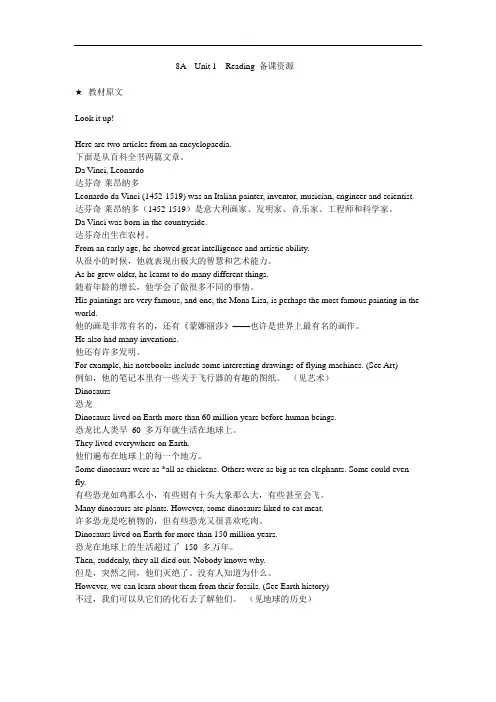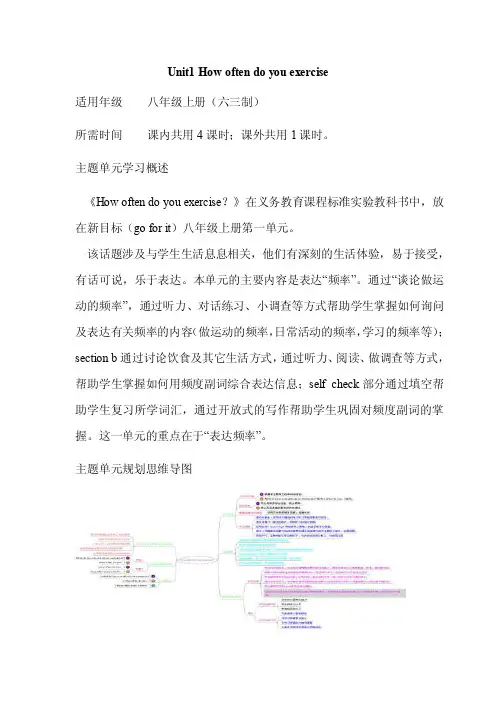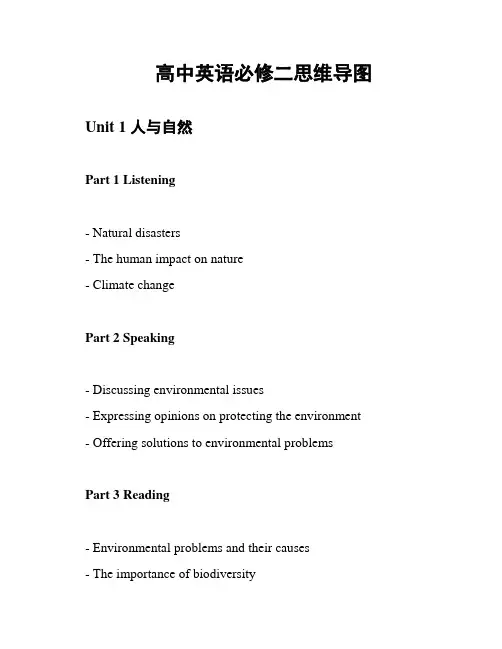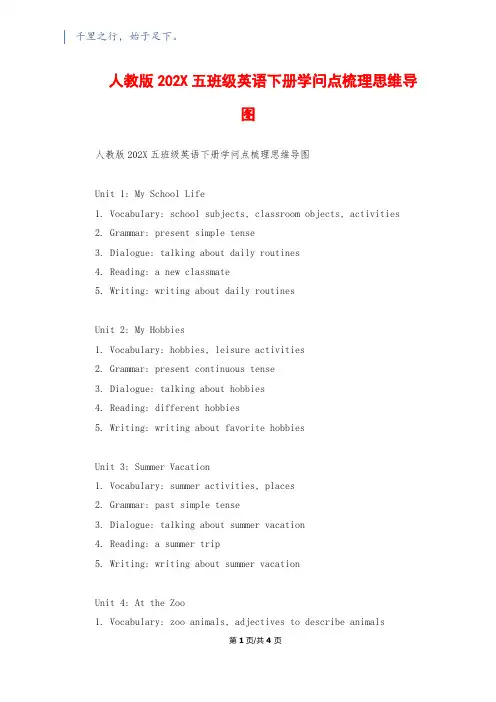思维导图unit1reading1
Unit1EncyclopaediasReading素材-辽宁省法库县东湖第二初级中学牛津深圳版(广州沈阳通用)八年级英语上册备课资源(课文翻译+思维导图+课文解析+配套习题+单词短语)

8A Unit 1 Reading 备课资源★教材原文Look it up!Here are two articles from an encyclopaedia.下面是从百科全书两篇文章。
Da Vinci, Leonardo达芬奇·莱昂纳多Leonardo da Vinci (1452-1519) was an Italian painter, inventor, musician, engineer and scientist. 达芬奇·莱昂纳多(1452-1519)是意大利画家、发明家、音乐家、工程师和科学家。
Da Vinci was born in the countryside.达芬奇出生在农村。
From an early age, he showed great intelligence and artistic ability.从很小的时候,他就表现出极大的智慧和艺术能力。
As he grew older, he learnt to do many different things.随着年龄的增长,他学会了做很多不同的事情。
His paintings are very famous, and one, the Mona Lisa, is perhaps the most famous painting in the world.他的画是非常有名的,还有《蒙娜丽莎》——也许是世界上最有名的画作。
He also had many inventions.他还有许多发明。
For example, his notebooks include some interesting drawings of flying machines. (See Art)例如,他的笔记本里有一些关于飞行器的有趣的图纸。
(见艺术)Dinosaurs恐龙Dinosaurs lived on Earth more than 60 million years before human beings.恐龙比人类早60 多万年就生活在地球上。
初中英语 译林牛津版七年级上下册知识梳理—思维导图课件

7A
重 点 点 睛
13
7A
重 点 点 睛
14
7A
重 点 点 睛
15
7A重点点睛
16
7A重点点睛
17
7A重点点睛
18
7B教材目录
Grade
Unit
Reading
Unit 1 Dream homes
Homes around
Task
My dream home
Grammar 1. 基数词2.序数词
行为动词的一般现在时(主谓一致、第三 人称单数规则、否定形式、一般疑问句、 区分助动词do和行为动词do的用法)
一般现 在时
Unit 3 Welcom Welcome to e to our our school ! school !
My school 人称代词(主格和宾格)
Unit 4 My day
Designing clothes
1. 用some和any表示数量2. There be结构(就近原则)
现在进行时(1.提示标志2.不用于现 在进行时的动词3.动词的现在分词构 成规则4.现在进行时的否定句、一般
疑问句和特殊疑问句)
现在进 行时
9
03
单元重点点睛
10
7A
重 点 点 睛
11
7A重点点睛
特殊疑问句
Unit 6 Food
and
Keeping fit
lifestyle
Healthy lifestyle
可数名词和不可数名词(可数名词复 数形式变化规则)
Unit 7 Shopping
Unit 8 Fashion
Going shopping
人教版九年级英语各单元主题思维导图(1-10)

Learning how to learn
单元整体话题篇
Structures
A: Do you learn English by reading aloud? B: Yes, I do. It helps with my pronunciation A: How can I improve my pronunciation? B: Well, one way is by listening to tapes.
阅读篇-Section B 2b
The Spirit of Christmas
Sharing and giving love and joy
The Best Example: A Christmas Carol (a novel by Charles Dickens)
three ghosts 1. the Ghost of... Past 2. the Ghost of... Present 3. the Ghost of... Yet to Come
Keep practicing what they have learnt
Be not afraid of making mistakes By writing down key words or by drawing mind maps
By reading notes every day or by explaining the information to another student
by working with friends /a group by writing e-mails to pen pals take notes by writing down key words or by drawing mind maps Maybe you should join an English club. Don't read word for word. Read word groups. Be patient. It takes time. Practice makes perfect.
初中英语《Unit1Howoftendoyouexercise》单元教学设计以及思维导图

Unit1 How often do you exercise适用年级八年级上册(六三制)所需时间课内共用4课时;课外共用1课时。
主题单元学习概述《How often do you exercise?》在义务教育课程标准实验教科书中,放在新目标(go for it)八年级上册第一单元。
该话题涉及与学生生活息息相关,他们有深刻的生活体验,易于接受,有话可说,乐于表达。
本单元的主要内容是表达“频率”。
通过“谈论做运动的频率”,通过听力、对话练习、小调查等方式帮助学生掌握如何询问及表达有关频率的内容(做运动的频率,日常活动的频率,学习的频率等);section b通过讨论饮食及其它生活方式,通过听力、阅读、做调查等方式,帮助学生掌握如何用频度副词综合表达信息;self check部分通过填空帮助学生复习所学词汇,通过开放式的写作帮助学生巩固对频度副词的掌握。
这一单元的重点在于“表达频率”。
主题单元规划思维导图主题单元学习目标知识与技能:1. 练习口语和听力的跟读。
2.掌握如何恰当地使用频率副词及短语:always, usually, often, sometimes, hardly ever, never, how often, once, twice, three times a week, every day, habit, What do you usually do on weekends? How often do you ...? 掌握如何描述课余时间的活动安排。
3. 掌握如何描述基本的饮食结构:milk, junk food, health, unhealthy4. 能够综合各种信息,准确地表述频率。
过程与方法:1、通过研究并总结日常活动安排,初步体验研究性学习的基本过程。
2、通过用多媒体创设情境,学生体验到信息技术在英语课中的应用。
情感态度与价值观:1.通过研究并总结问题,学生更好地学会合作和探究2.了解自己与他人的日常生活安排,养成良好的生活学习作息习惯对应课标1.能听懂有关话题的谈话,并能从中提取信息。
高中英语必修二思维导图

高中英语必修二思维导图Unit 1 人与自然Part 1 Listening- Natural disasters- The human impact on nature- Climate changePart 2 Speaking- Discussing environmental issues- Expressing opinions on protecting the environment - Offering solutions to environmental problemsPart 3 Reading- Environmental problems and their causes- The importance of biodiversity- Ways to preserve the natural environmentPart 4 Writing- Describing the impact of human activities on the environment - Writing an argumentative essay on environmental protection - Suggesting measures to reduce pollution and promote sustainabilityUnit 2课文导读Part 1 Listening- Understanding the main ideas of the text- Identifying supporting details- Discussing the author's point of viewPart 2 Speaking- Discussing the themes and characters in the text- Analyzing the text's structure and language use- Relating the text to personal experiences or similar literary works Part 3 Reading- Analyzing the text's writing style and literary devices- Interpreting the text's underlying themes and messagesPart 4 Writing- Writing a summary of the text- Writing a character analysis- Reflecting on the text's themes and their relevance in modern societyUnit 3中的教室思维导图Part 1 Listening- Classroom activities and routines- Group dynamics and collaboration- Effective learning strategiesPart 2 Speaking- Discussing classroom rules and etiquette- Expressing opinions on different teaching methods- Reflecting on the importance of individual effort and cooperation Part 3 Reading- Understanding different learning styles- Problem-solving techniques- Critical thinking and decision-making skillsPart 4 Writing- Describing a memorable classroom experience- Writing a persuasive essay on the benefits of group work- Reflecting on personal learning strategies and setting goals for improvementUnit 4课文导读Part 1 Listening- Understanding the main ideas of the text- Identifying literary devices and figurative language- Discussing the author's purpose and messagePart 2 Speaking- Analyzing the characters and their relationships in the text- Exploring the text's themes and symbolsPart 3 Reading- Analyzing the text's structure and narrative techniques- Interpreting the text's cultural and historical contextPart 4 Writing- Exploring the text's themes and their relevance in society - Analyzing the author's use of language and style。
人教版202X五年级英语下册知识点梳理思维导图

人教版202X五班级英语下册学问点梳理思维导图人教版202X五班级英语下册学问点梳理思维导图Unit 1: My School Life1. Vocabulary: school subjects, classroom objects, activities2. Grammar: present simple tense3. Dialogue: talking about daily routines4. Reading: a new classmate5. Writing: writing about daily routinesUnit 2: My Hobbies1. Vocabulary: hobbies, leisure activities2. Grammar: present continuous tense3. Dialogue: talking about hobbies4. Reading: different hobbies5. Writing: writing about favorite hobbiesUnit 3: Summer Vacation1. Vocabulary: summer activities, places2. Grammar: past simple tense3. Dialogue: talking about summer vacation4. Reading: a summer trip5. Writing: writing about summer vacationUnit 4: At the Zoo1. Vocabulary: zoo animals, adjectives to describe animals第1页/共4页2. Grammar: can/can't for ability3. Dialogue: talking about animals at the zoo4. Reading: a visit to the zoo5. Writing: writing a report about the zoo animalsUnit 5: In the Countryside1. Vocabulary: nature, countryside, weather2. Grammar: present perfect tense3. Dialogue: talking about countryside activities4. Reading: life in the countryside5. Writing: writing a blog about a countryside tripUnit 6: My Family1. Vocabulary: family members, adjectives to describe family members2. Grammar: possessive pronouns3. Dialogue: talking about family members4. Reading: a family tree5. Writing: writing about family membersUnit 7: Festivals and Customs1. Vocabulary: festivals, customs, traditions2. Grammar: future tense3. Dialogue: talking about festivals and customs4. Reading: different festivals around the world5. Writing: writing about a festivalUnit 8: Helping Others1. Vocabulary: community helpers, volunteer work2. Grammar: imperative sentences3. Dialogue: talking about helping others4. Reading: different ways to help others5. Writing: writing about a volunteering experienceUnit 9: Sports and Games1. Vocabulary: sports, games, equipment2. Grammar: comparative and superlative adjectives3. Dialogue: talking about sports and games4. Reading: different sports and games5. Writing: writing about a favorite sport or gameUnit 10: Outings1. Vocabulary: outdoor activities, transportation2. Grammar: prepositions of place and time3. Dialogue: talking about outings4. Reading: a school outing5. Writing: writing a diary entry about an outingUnit 11: Food and Drink1. Vocabulary: food, drinks, healthy eating2. Grammar: countable and uncountable nouns3. Dialogue: talking about food and drink4. Reading: a visit to a farm5. Writing: writing a recipeUnit 12: My Country1. Vocabulary: countries, cities, landmarks2. Grammar: past continuous tense3. Dialogue: talking about countries and cities第3页/共4页4. Reading: a travel brochure5. Writing: writing about a dream vacation以上是人教版202X五班级英语下册的学问点梳理思维导图,包括词汇、语法、对话、阅读和写作等内容,挂念同学系统地整理和学习课程学问,提高英语综合力量。
译林版高中英语必修二Unit 1 Reading (I) 教案
《英语》(必修·第二册)Unit 1 Lights, camera, action!Welcome to the unit & Reading (I)I. Learning objectivesBy the end of the lesson, students will be able to:1. grasp the way of understanding a lecture transcript;2. know about some unfamiliar aspects of film-making;3. think critically and express their opinions on some special effects technology in film-making;4. think of and appreciate the talented people and their hard work behind the scenes.II. Key competence focus1. Analyse and summarize the structure of the text.2. Think critically and express opinions freely.III. Predicted area of difficultyUnderstand the structure and the language style of the lecture transcript.IV. Teaching proceduresStep 1 Brainstorming: stimulating reading interest1.T plays the theme music of Harry Potter films in class.2.T leads Ss to talk about films by answering the following three questions:•Could you list some film types? (action, horror, cartoon, musical, comedy, romance, documentary, science fiction, fantasy, war ...)•Look at the film posters on page 1. What type of film is shown on each poster?•What elements of a film can you think of?【设计意图:课前播放“哈利·波特”系列电影的主题音乐,营造气氛,为课堂主题做好铺垫。
牛津译林版八年级英语上册Unit 1 Reading (I) 示范课教学设计
活动层次
学习理解之概括与整合
查看学生的作答情况,了解他们获取阅读语篇关键信息的情况。
环节设计意图:
通过不同的阅读活动,培养学生获取文章大意及关键信息的能力,帮助学生理清文章内容,同时表格的形式能够帮助学生建立框架意识。
训练学生在真实情境中运用目标语言的能力。
环节六:基于语篇,探究主题意义。(4 mins)
教师引导学生思考问题,探究“朋友”的重要性。
教学活动
14. Students discuss the questionwhy they need friends.
活动层次
迁移创新之推理与论证
效果评价
倾听学生的讨论,了解学生对主题意义的理解程度。
环节设计意图:
升华主题,引导学生了解语篇背后所蕴含的情感态度。
作业与拓展
1. Finish the exerciseB1.
2. Review the new words and phrasesthey’ve learnt today.
二、语篇分析
【What】
本节课的话题是“最好的朋友”,属于人与社会主题下的主题群“社会服务与人际沟通”,子话题为“良好的人际关系与社会交往”。阅读文本包含了三个语篇,分别介绍了三个好朋友的外貌、品质等。
【Why】
在每个学生成长的过程中,朋友都是一笔重要的财富。本节课旨在引导学生结合自己在平时生活中与朋友相处的经历学习语言,意识到朋友的重要性,学会珍视友谊。
环节设计意图:
通过看图说话和匹配活动,帮助学生熟悉话题,同时在情境中学习新词,有利于加深学生对新词的理解。通过预测活动,进一步帮助学生了解话题,培养学生读前预测的意识和习惯,有效降低阅读难度。
英语单词记忆方法—思维导图法(一)
英语单词记忆方法—思维导图法(一)说明:本资料包括五个部分的内容即:第一部分概念呈现,利用“图”与“文”先建立第一印象。
第二部分单词资料库,包括单词的基本资料、单词例句、相关单词补充、有趣信息补给等内容。
第三部分思维导图串连,第一层是大主题(Unit),之后是当前单元的小主题。
延伸出去的30条线段,每一条线段都有一个单词,即:大主题→小主题→单词。
第四部分阶段性的小测试,巩固记忆。
第五部分参考答案。
目录:Theme 1 Place 地点Unit 1 Home 家Unit 2 Rooms 房间Unit 3 Airport 机场Unit 4 Restaurant 餐厅Unit 5 City 城市Unit 6 Country 乡下Answer KeyTheme 1 Place 地点Unit 1 Home 家1address/əˈdres/n. 地址;演说;谈吐•There isn't enough space for my address. 这里没有足够的空间写我的住址。
•change one's address 变更某人的地址•tell me your address 告诉我你的地址2location/ləuˈkeiʃən/n. 定位,测位;测量•First, we must decide on the location of our new swimming pool. 我们得先给新游泳池选个地点。
•Mr. Huang's company is going to move to a new location. 黄先生的公司将要搬到一个新的地点。
3habitation/ˌhæbiˈteiʃən/ n.居住,住所•We think this house is unfit for human habitation,so we have decided to move. 我们觉得这房子不适合人居住,所以我们决定要搬走。
人教版英语五下1一3单元作文思维导图
人教版英语五下1一3单元作文思维导图全文共3篇示例,供读者参考篇1Unit 1-3 in Grade 5 of the People's Education Edition English textbook mainly focuses on topics related to daily routines, family members, and hobbies. In this unit, students are introduced to vocabulary and sentence structures that will help them describe their daily activities, talk about their family members, and discuss their hobbies.To make the learning process more effective and engaging, a concept map can be created to visually organize the key information and concepts covered in these three units. Here is an outline of the concept map for Unit 1-3:1. Daily Routines:- Vocabulary: wake up, brush teeth, wash face, have breakfast, go to school, do homework, go to bed- Sentence structures: I wake up at 7 o'clock. I brush my teeth after breakfast. I go to school by bus.2. Family Members:- Vocabulary: father, mother, brother, sister, grandparents, aunt, uncle- Sentence structures: My father works in an office. My mother is a teacher. I have two brothers and one sister.3. Hobbies:- Vocabulary: read books, play football, draw pictures, listen to music, watch TV, dance- Sentence structures: I like to read books in my free time. My brother enjoys playing football. My sister loves to draw pictures.By creating a concept map for Unit 1-3, students can visually see the connections between the different topics and reinforce their understanding of the vocabulary and sentence structures. This visual aid can also serve as a useful study tool for students to review and practice the language concepts covered in these units.篇2Title: Mind Map for Unit 1-3 in Grade 5 English (People's Education Edition)Introduction:In this essay, I will present a mind map for Unit 1-3 in Grade 5 English from the People's Education Edition. The mind map will cover the key themes, vocabulary, grammar structures, and reading comprehension strategies from these units.Key Themes:1. Unit 1: My School Life- School facilities- Daily routines- Classroom rules2. Unit 2: My Friends- Describing friends- Hobbies and interests- Friendship qualities3. Unit 3: My Family- Family members- Family activities- Family relationshipsVocabulary:- Unit 1: Words related to school, such as classroom, teacher, student, homework, etc.- Unit 2: Words related to friendship, like friend, loyal, kind, thoughtful, etc.- Unit 3: Words related to family, such as mother, father, brother, sister, etc.Grammar Structures:- Unit 1: Present simple tense for daily routines- Unit 2: Comparative adjectives for describing friends- Unit 3: Possessive pronouns for talking about family membersReading Comprehension Strategies:- Skimming and scanning for key information- Identifying main ideas and supporting details- Making inferences based on context cluesConclusion:In conclusion, the mind map for Unit 1-3 in Grade 5 English from the People's Education Edition provides a comprehensive overview of the key themes, vocabulary, grammar structures, andreading comprehension strategies covered in these units. By using this mind map as a study guide, students can enhance their understanding of the English language and improve their language skills.篇3Topic: Mind Map on Unit 1-3 of Grade 5 English in People's Education PressIntroduction:In this mind map, we will explore the key themes, vocabulary, grammar, and learning objectives from Unit 1-3 of Grade 5 English in People's Education Press. By using a visual representation of the content, we aim to enhance the understanding and memory retention of the students.Main Body:1. Unit 1: Welcome Back to School- Themes: School life, routines, classmates- Vocabulary: Classroom, teacher, student, pencil, eraser- Grammar: Present simple tense (e.g. I go to school every day.)- Learning Objectives: Describe school life, talk about routines, introduce oneself and others2. Unit 2: What's the time, please?- Themes: Telling the time, daily activities, schedules- Vocabulary: Hour, minute, clock, watch, schedule- Grammar: Questions and responses related to time (e.g. What time is it? It's three o'clock.)- Learning Objectives: Ask and tell the time, talk about daily activities, understand schedules3. Unit 3: How do you get to school?- Themes: Transportation, directions, means of transport- Vocabulary: Bus, bike, walk, car, subway- Grammar: Present continuous tense (e.g. I am walking to school.)- Learning Objectives: Describe how to get to places, give and follow directions, talk about means of transportationConclusion:By creating a mind map on Unit 1-3 of Grade 5 English in People's Education Press, we have highlighted the importantaspects of each unit, including themes, vocabulary, grammar, and learning objectives. This visual representation can serve as a helpful study tool for students to review and reinforce their understanding of the content covered in these units. Happy learning!。
- 1、下载文档前请自行甄别文档内容的完整性,平台不提供额外的编辑、内容补充、找答案等附加服务。
- 2、"仅部分预览"的文档,不可在线预览部分如存在完整性等问题,可反馈申请退款(可完整预览的文档不适用该条件!)。
- 3、如文档侵犯您的权益,请联系客服反馈,我们会尽快为您处理(人工客服工作时间:9:00-18:30)。
in search of, design, decorate, belong to, remove, doubt… important sentences: It was also a treasure decorated with gold and jewels, which took the country’s best artists about ten years to make. However, the next King of Prussia, Frederick William I, to whom the amber room belonged, decided not to keep it. There is no doubt that the boxes were then put on a train for Konigsberg, which was at that time a German city on the Baltic Sea. After that, what happened to the Amber Room remains a mystery.
……………. .
Stonehenge
London Bridge
Cultural
The statue of
relics
…
liberty
Sydney Opera House
The pyramids
Are there any other forms of cultural relics
Mona Lisa
表达出来,有助于提升学生以后的写作能力。
Frederick I
Pass down
Frederick William I
Give it as a gift
Send a troop of his best soldiers in return
Peter the Great Czar
Pass down
Catherine II
stolen
设计意图:寻读(scanning)与思维导图相结合,一目了然地显示了该文章的大 意,有利于学生复述文章。
Para 1: Creation of the Amber Room
In search
of
the
Amber Room
Para 2~3: History of the Amber Room
Para 4: Disappearance of the Amber Room
Para 5: Rebuilding of the Amber Room
设计意图:略读(skimming),作为一种阅读策略,可以培养学生在有限的时间 内,通过快速阅读标题,文章开头第一段以及各部分的小标题,弄清楚文章的大 体结构和主要内容的能力。通过思维导图清晰地将文章结构呈现出来。 2. Scanning
T: Read the text loudly for a second time and fin the characters, years, places and what they do.
for them. Teaching procedures: Step 1 Lead-in (Brainstorming) The teacher starts the lesson by asking a question: What are cultural
relHow about Chinese
main idea. awareness and emotional attitude aims: Learn about some cultural relics at home and abroad and have the sense of protecting them Teaching key point: To make students know the history of the Amber Room . Teaching difficult points: Talk about cultural relics and what can be done
vase
painting s
art works
Other Examples
Festivals
art forms
The Dragon boat Festival
设计意图:通过提问学生关于他们所知道的文化遗产,能够让其充分使用头脑风 暴,同时通过使用思维导图,能够让学生利用大的范围 自主理解,以便加深其印象,特别是第三个问题。
cultural relics
The Potala Palace
The Terra-cotta Warriors and Horses
Chinese
cultural
relics relics reli
The Dunhuang Mogao Cave
The Imperial Palace
T: What cultural relics do you know in the world
Step 2 Reading Strategy
T: Do you know amber Can you imagine a room made of amber Now turn to Page 1, read the reading part quickly and then summarize the main idea of each para.
2. Ability aims: Enable students to talk about the history of the Amber Room. strategies aims: Enable the students to read the passage fast to get the
Step 3 Discussion 1. What can we do to protect the cultural relics 2. Now China has tens of thousands of cultural relics, should all be saved
Discuss and give your reasons. 设计意图:将常见问题通过讨论的方式呈现出来,在大家的共同合作下,更好 地解决问题。 Step 4 Homework Write a composition according to your discussion. 设计意图:课外作业的布置考虑到了学生的表达能力,通过把语言的东西书面
